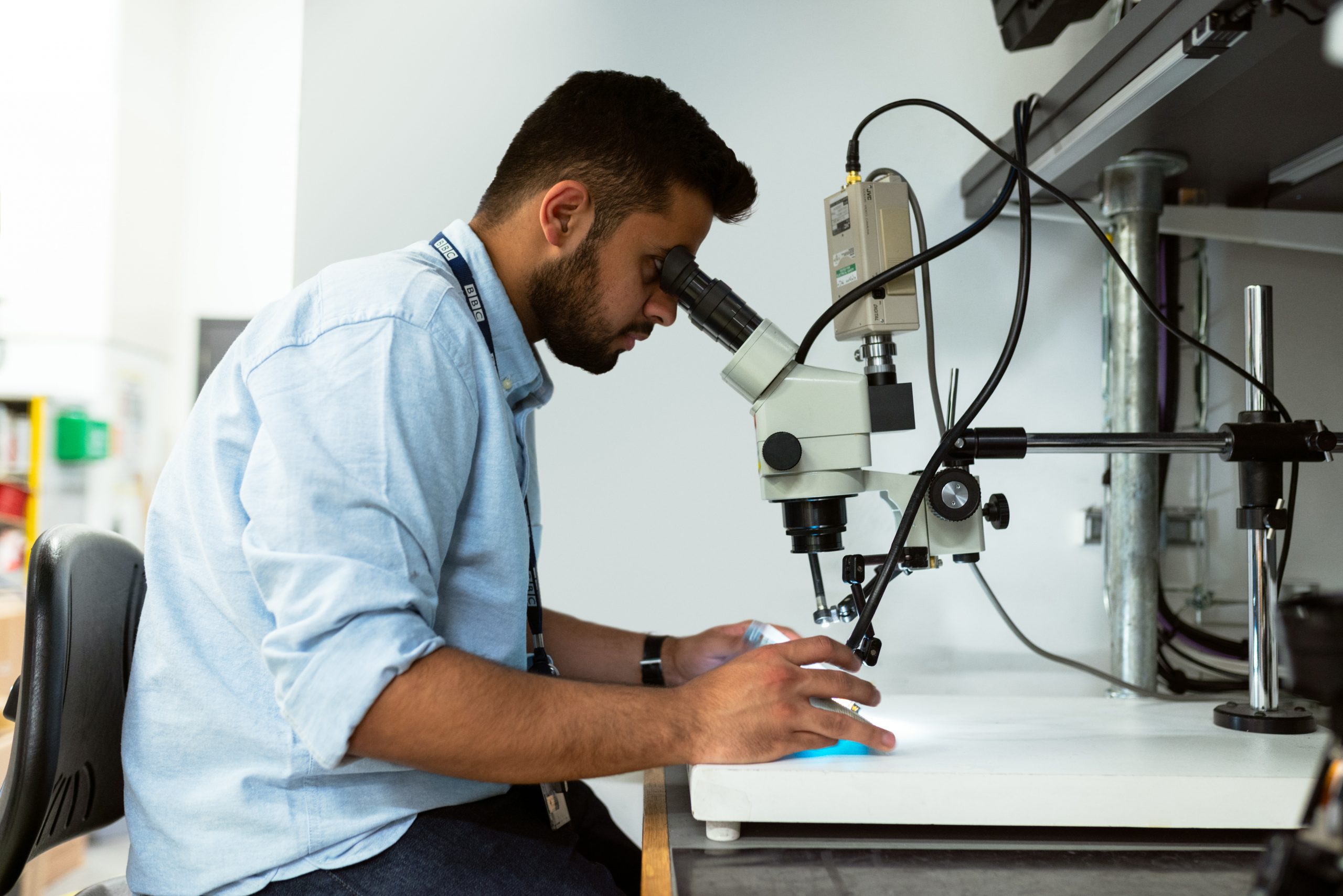
CHIPS and Science Funding Update: FY 2023 Omnibus, FY 2024 Budget Both Short by Billions
See PDF for more charts.
When Congress adopted the CHIPS and Science Act (P.L. 117-167) in 2022 on bipartisan votes, it was motivated by several concerns and policy goals. A major overarching theme is the global competition for technology and prominence in the knowledge economy, and the place of the United States in it. More broadly, Congress also sought to improve the ability of federal agencies to invest in R&D to create solutions for national challenges. To that end, the Act took a broad array of policy steps well beyond semiconductors: providing strategic focus for the federal technology enterprise, creating programs to invest in U.S. workers and regions, expanding the funding toolkit, and authorizing sizable boosts for R&D across the spectrum.
But neither the FY 2023 Consolidated Appropriations Act nor the Biden Administration’s FY 2024 budget request have managed to keep up with the agency funding commitments established in the act. FY 2023 omnibus funding was nearly $3 billion short of the authorized targets for the National Science Foundation, the Department of Energy’s Office of Science, and the National Institute of Standards and Technology. The FY 2024 request for these agencies is over $5 billion short (see graph below).
This report provides a detailed breakdown of accounts and programs for these agencies and compares current funding levels against those authorized by CHIPS and Science. The report is intended to serve as a reference and resource for policymakers and advocates as the FY 2024 appropriations cycle unwinds.

Based on agency and legislative data and the FY 2024 budget. | Federation of American Scientists
CHIPS and Science Background
As mentioned above and covered more fully below, CHIPS and Science took manifold steps to strengthen the U.S. science and technology enterprise. A conceptual throughline in the Act is the establishment of key technology focus areas and societal challenges defined in Section 10387, shown in the table below. While not the only priorities for the federal R&D enterprise, these focus areas provide a framework to guide certain investments, particularly those by the new NSF technology directorate.
These key technology areas are also relevant for long-term strategy development by the Office of Science and Technology Policy and the National Science and Technology Council, as directed by CHIPS and Science. Several of the technology areas also appear on the Defense Department’s Critical Technologies list.
| >> Key Technology Focus Areas >> | |
| AI, machine learning, autonomy* | Advanced communications and immersive technologies* |
| Advanced computing, software, semiconductors* | Biotechnology* |
| Quantum information science* | Data storage and management, distributed ledger, cybersecurity* |
| Robotics, automation, advanced manufacturing | Advanced energy technology, storage, industrial efficiency* |
| Natural / anthropogenic disaster prevention / mitigation | Advanced materials science* |
| * Also related to OUSD(R&E)-identified Defense Critical Technology Area |
|
| >> Societal / National / Geostrategic Challenges >> | |
| U.S. national security | Climate change and sustainability |
| Manufacturing and industrial productivity | Inequitable access to education, opportunity, services |
| Workforce development and skills gaps | |
| Adapted from H.R. 4346, Sec. 10387 | |
While much of the focus has been on semiconductors, the activities covered in this report constitute the bulk of the “and Science” portion of CHIPS and Science. While a full index of all provisions is not the goal here, it’s worth remembering the sheer variety of activities authorized in CHIPS and Science, which cut across a few broad areas including:
- Fundamental science and curiosity-driven research funded by science agencies at federal labs, universities, and companies. CHIPS and Science covered multiple disciplines but has a particular emphasis on the physical sciences, math and computer science, and engineering. Several of these disciplines have fallen dramatically within the federal portfolio in recent decades.
- Use-inspired research, translation, and production. Elements of CHIPS and Science sought to expand the ability of federal agencies to make strategic investments in emerging technologies, move new advances through the innovation chain, and work with external partners to enable the manufacture of new technologies and strengthen supply chains.
- Regional innovation. A major element of the above is emphasis on expanding the geographic footprint of federal investment, most notably through the new Regional Technology and Innovation Hubs program. The program received $500 million out of an authorized $10 billion in the FY 2023 omnibus.
- STEM education and workforce. The Act expands or creates numerous programs to foster STEM skills, opportunity and experience among students and young researchers, including through entrepreneurial fellowships, student and educator support, and apprenticeships and worker upskilling initiatives.
- Research facilities and instrumentation at national labs and universities across the country, including modernization of aging infrastructure, construction of cutting-edge user facilities, and grants for mid-scale research infrastructure projects.
Agency Fiscal Aggregates
In the aggregate, CHIPS authorized three research agencies – the National Science Foundation (NSF), the Department of Energy Office of Science (DOE Science), and the National Institute of Standards and Technology (NIST) – to receive $22.4 billion in FY 2023. The final omnibus provided $19.6 billion in the aggregate, amounting to a $2.7 billion or 12% shortfall.

As seen in Table 1, the largest shortfall from the CHIPS authorization was NSF at $2 billion or 17% below the target. NIST’s appropriation actually surpassed the authorization by $103 million, but this figure includes $395 million in earmarks. Excluding earmarks, the NIST topline appropriation tallied to $1.3 billion, a $292 million or 19% shortfall below the authorization. Note the figures in Table 1 include $1.0 billion in supplemental appropriations for NSF – amounting to its entire year-over-year increase in FY 2023 – and $27 million in supplemental appropriations for NIST.
The White House requested an aggregate $21.7 billion for FY 2024: a $2.8 billion or 15% increase above FY 2023 omnibus levels (including earmarks and supplemental spending) but still $5.1 billion or 19% below the CHIPS and Science authorization in the aggregate. Again, NSF would be subject to the biggest miss below the authorized target.
Agency Breakdowns
National Science Foundation
NSF is at the core of the CHIPS and Science goals in manifold ways. It boasts a long-term track record of excellence in discovery science at U.S. universities and is the first or second federal funder of research in several tech-relevant science and engineering disciplines. It also seeks to boost the talent pipeline by engaging with underserved research institutions and student populations, supporting effective STEM education approaches, and providing fellowships and other opportunities to students and teachers.
CHIPS and Science also expanded NSF’s ability to drive technology, innovation, and advanced manufacturing, augmenting existing innovation programs like the Engineering Research Centers and the Convergence Accelerators with new activities like the Regional Innovation Engines.

As seen in Table 2, the FY 2023 appropriation for NSF – including $1.0 billion in supplemental spending – fell $2.0 billion or 17% below the CHIPS and Science target, while the FY 2024 request is $4.3 billion or 28% below the FY 2024 target. Additional details and comparisons between appropriations, authorizations, and the request follow.
Research & Related Activities (R&RA). R&RA is the primary research account for NSF, supporting grants, centers, instrumentation, data collection, and other activities across seven directorates including the new Technology, Innovation, and Partnerships (TIP) directorate. R&RA can likely absorb substantial additional funding: the agency must routinely leave thousands of high-scoring grant proposals on the table for lack of funding. For instance, in FY 2020 alone, NSF had to leave over 4,000 proposals ranked “Very Good” or better unfunded. These amounted to $3.9 billion in total unfulfilled award funding. A brief look at specific line items within the R&RA account are below.
- Core Research Directorates. Most R&RA funding is channeled through the six research directorates focusing on biology, computing and information science, engineering, geoscience, math and computer science, and social science, as well as integrated and international programs. These directorates play a foundational role in fostering U.S. scientific disciplines, including several that are germane to CHIPS technology priorities. Congress typically – and wisely – does not provide appropriations by individual directorate, and instead appropriates a lump sum for R&RA that is then allocated by the agency, though appropriators do sometimes specify funding amounts for line items or research topics. Accordingly, most of the R&RA authorization in CHIPS and Science is unspecified with two exceptions: $55 million for mid-scale research infrastructure projects, which was fully funded in the FY 2023 omnibus; and the TIP Directorate, covered below. Excluding these elements, core R&RA funding received $6.9 billion in the FY 2023 omnibus, about $591 million or 8% below the authorized level. Core R&RA funding in the request – again excluding TIP and mid-scale infrastructure – is $846 million or 10% below the authorized level.
- Directorate for Technology, Innovation and Partnerships (TIP). (FY 2023 funding: $880 million, $620 million below authorization; FY 2024 OMB request: $1.2 billion, $2.2 billion below authorization). NSF TIP was formally established in the CHIPS and Science Act to support translational, use-inspired, and solutions-oriented R&D and to deploy novel funding modes to accelerate innovation. Authorizers set a TIP funding target of $1.5 billion in FY 2023 and $3.4 billion in FY 2024, representing by far the most ambitious appropriations targets in the bill. FY 2023 funded was allocated by the agency rather than Congress, which should continue its practice of lump-sum appropriations for R&RA mentioned above. The FY 2024 TIP request is billions short of the authorized level yet also seeks the largest increase of any NSF directorate. Within TIP, CHIPS authorized $6.5 billion over five years combined for regional innovation engines and innovation translation accelerators and $125 million over five years for NSF entrepreneurial fellows, along with test beds, scholarships, R&D, and other activities.
STEM Education. The Directorate for STEM Education houses NSF activities across K-12, tertiary education, learning in informal settings, and outreach to underserved communities. CHIPS and Science authorized multiple individual programs including:
- Graduate Research Fellowship Program (FY 2023 funding: $322 million, $94 million below authorization; FY 2024 request: $380 million, $74 million below authorization). The program provides an excellent opportunity for students pursuing STEM careers while seeking to broaden participation.
- Robert Noyce Teacher Fellowship Program (FY 2023 funding: $69 million, $5 million below authorization; FY 2024 OMB request: $77 million, $3 million below authorization). The fellowship provides stipends, scholarships, and programmatic support to prepare and recruit highly skilled STEM professionals to become K-12 teachers in high-need districts. The CHIPS and Science Act aims to increase outreach to historically Black colleges and universities, minority institutions, higher education programs that serve veterans and rural communities, labor organizations, and emerging research institutions.
- CyberCorps (FY 2023 funding: $86 million, $16 million above authorization; FY 2024 OMB request: $74 million, $2 million above authorization). One of the few programs for which funding topped CHIPS authorized levels, CyberCorps aims to address the shortage of cybersecurity educators and researchers and augment the federal workforce by funding scholarships in exchange for a period of federal service.
- Centers for Transformative Education Research and Translation: This new program is intended to pursue multidisciplinary R&D into education innovations. under-resourced schools and learners in low-resource or underachieving local educational agencies in urban and rural communities.

Cross-Cutting Investments in Key Technology Focus Areas. Several NSF investments are related to the key technology areas and societal challenges prioritized in CHIPS section 10387 mentioned above. A breakout of some of these is below, taken from the NSF budget justification. Funding for these research activities is spread across all NSF directorates.
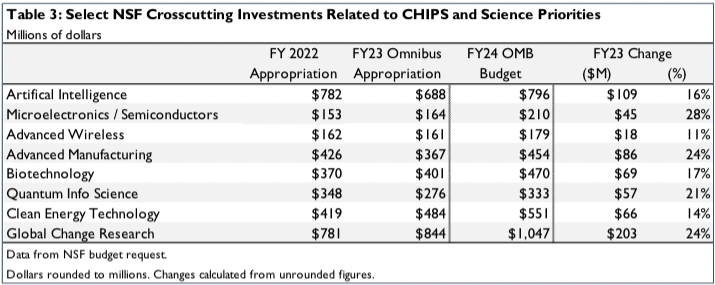
Department of Energy Office of Science
The Office of Science (SC) is the largest funder of the physical sciences including chemistry, physics, and materials, all of which contribute to the technology priorities in CHIPS and Science. In addition to funding Nobel prizewinning basic research and large-scale science infrastructure, the Office also funds workforce development, use-inspired research, and user facilities that provide tools for tens of thousands of users each year, including hundreds of small and large businesses that use these services to drive breakthroughs. More than two thirds of SC-funded R&D is performed at national labs. SC also supports workforce development and educational activities for students and faculty to expand skills and experience.

As seen in Table 4, the FY 2023 omnibus topline for SC was $802 million or 9% below the authorized amount, while the FY 2024 OMB request was $741 million or 8% below the FY 2024 authorization – and indeed even fell below the FY 2023 authorization, similar to NSF’s request. Most programs would see only moderate funding increases, with fusion clearly prioritized.
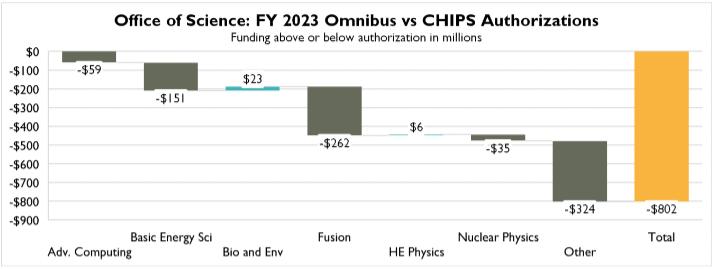
Funding above or below authorizations in millions
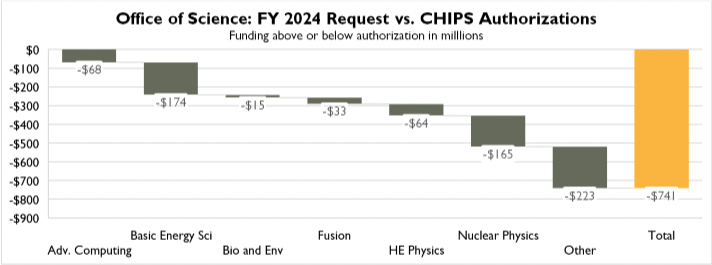
Funding above or below authorizations in millions
- Advanced Scientific Computing Research (ASCR) funds research in AI, computational science, mathematics, and networking. Among CHIPS and Science priorities, ASCR will begin to establish a dedicated Quantum Network along with other research, testbeds, and applications in FY 2024. CHIPS authorized quantum network infrastructure at $100 million in FY 2024 and quantum hardware and research cloud access at $31.5 million in FY 2024. CHIPS and Science also authorized Computational Sciences Graduate Fellowships at $16.5 million in FY 2024.
- Basic Energy Sciences (BES), the largest SC program, supports fundamental science disciplines with relevance for several CHIPS technology areas including materials, microelectronics, AI, and others, as well as extensive user facilities and novel initiatives like the Energy Earthshots. CHIPS and Science priorities included research and innovation hubs related to artificial photosynthesis ($100 million authorized in FY 2024) and energy storage ($120 million authorized in FY 2024). It also authorized $50 million per year for carbon materials and storage research in coal-rich U.S. regions. The FY 2024 request prioritizes budget growth in support of the program’s x-ray light sources and neutron sources.
- Biological and Environmental Research (BER) supports research in biological systems science including genomics and imaging, and in earth systems science and modeling. BER programs would generally see minimal changes from FY 2024, with a moderate funding boost for the Biopreparedness Research Virtual Environment to expand to include low dose radiation research, a CHIPS and Science priority area.
- Fusion Energy Sciences (FES) supports research into matter at high densities and temperatures to lay the groundwork for fusion as a future energy source. Following the breakthrough at the National Ignition Facility, the FY 2024 request ramps up commercial development and places industry partnerships – including technology roadmapping for a fusion pilot project as highlighted in CHIPS and Science – and establishment of four new fusion R&D centers among its fiscal priorities. It also seeks to largely sustain support for international ITER project.
- High Energy Physics (HEP) studies fundamental particles constituting matter and energy. The FY 2024 request prioritizes the Long Baseline Neutrino Facility/Deep Underground Neutrino Experiment (LBNF/DUNE) while trimming research overall.
- Nuclear Physics (NP) conducts fundamental research to understand the properties of nuclear matter. The FY 2024 budget for NP is nearly flat, with a near-doubling of funding for Brookhaven’s Electron Ion Collider offsetting funding tightening elsewhere.
Cross-Cutting Investments in Key Technology Focus Areas. As with NSF, SC provides data on investments in crosscutting technology areas, some of which were prioritized in CHIPS and Science (Table 5). These investments involve multiple SC programs.
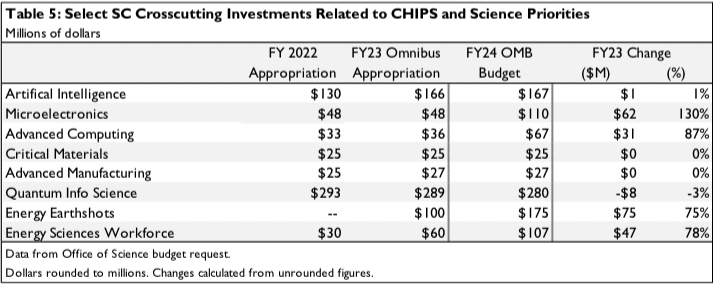
National Institute of Standards and Technology
While smaller than the other agencies covered here, NIST plays a critical role in the U.S. industrial ecosystem as the lead agency in measurement science and standards-setting, as well as funder of world-class physical science research and user facilities. NIST R&D activities cover several CHIPS And Science technology priorities including cybersecurity, advanced communications, AI, quantum science, and biotechnology. NIST also boasts a wide- ranging system of manufacturing extension centers in all 50 states and Puerto Rico, which help thousands of U.S. manufacturers grow and innovate every year.

As seen in Table 6, the NIST topline in the FY 2023 omnibus was $103 million above the CHIPS-authorized level. However, as noted in the above section, NIST received $395 million in Congressionally directed spending or earmarks in FY 2023, mainly for construction projects. Excluding earmarks, the NIST topline amounted to $1.3 billion, a $292 million or 19% shortfall below the authorization. The FY 2024 request is $20 million below the FY 2024 authorized level, with shortfalls in NIST labs programs and industrial technology.
Scientific and Technical Research Services (STRS) is the account for NIST’s national measurement and standards laboratories, which pursue a wide variety of CHIPS and Science-relevant activities in cybersecurity, AI, quantum information science, advanced communications, engineering biology, resilient infrastructure, and other realms. STRS also funds two user facilities, the NIST Center for Neutron Research and the Center for Nanoscale Science and Technology. In addition to FY 2024 investments in climate resilient infrastructure, research instrumentation, and other topics, large CHIPS and Science-relevant program increases include:
- Critical Technology Research ($20 million / 15% increase): In FY 2024, NIST lab programs will seek expanded investment in AI, quantum information science, biotechnology, and advanced communications. This will enable the establishment of AI technology testbeds, improve quantum metrology and support quantum technology development, promote rapid development and translation of biotechnologies and biomanufacturing processes, and advance measurement science and standards for next-generation communications.
- Cybersecurity and Privacy ($20 million / 21% increase): Funding will support research, standards development, and demonstrations of solutions through NIST’s National Cybersecurity Center of Excellence. These activities will touch on an array of critical areas including biometrics, cryptography, Internet of Things devices, and others. NIST will also continue to support cybersecurity workforce development. In addition to the above, NIST also requests $4 million for cybersecurity-relevant activities related to trustworthy supply chains.
Industrial Technology Services is the overarching account funding the Hollings Manufacturing Extension Partnership (MEP) and the Manufacturing USA innovation network. As can be seen in Table 6, these programs collectively faced a much greater authorization shortfall than NIST lab programs in the FY 2023 omnibus, while the FY 2024 request goes to great lengths to increase their funding.
- Hollings MEP would use the FY 2024 boost to support the National Supply Chain Optimization and Intelligence Network, to be established in FY 2023, and to expand workforce upskilling, apprenticeships, and partnerships with historically black colleges, minority-serving institutions and community colleges.
- Manufacturing USA would establish testbeds throughout the network of manufacturing innovation institutes established by the Departments of Defense and Energy, support a new NIST-sponsored institute to be competed in FY 2023, and further assist small manufacturers with prototyping and scaling of new technologies.
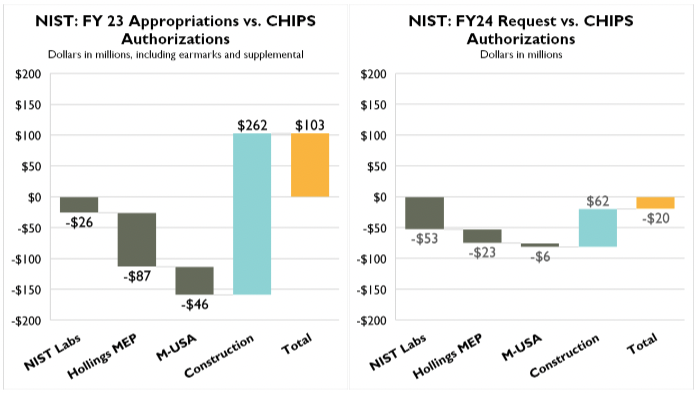
Future Updates
Federation of American Scientists will create an update to this report as the relevant FY 2024 appropriations bills move through the Congressional process.
When the U.S. government funds the establishment of a platform for testing hundreds of behavioral interventions on a large diverse population, we will start to better understand the interventions that will have an efficient and lasting impact on health behavior.
Integrating AI tools into healthcare has an immense amount of potential to improve patient outcomes, streamline clinical workflows, and reduce errors and bias.
Whole Health is a proven, evidence-based framework that integrates medical care, behavioral health, public health, and community support so that people can live healthier, longer, and more meaningful lives.
Innovation Ecosystem Job Board connects scientists, engineers, technologists, and skilled federal workers and contractors who have recently departed government service with the emerging innovation ecosystems across America.